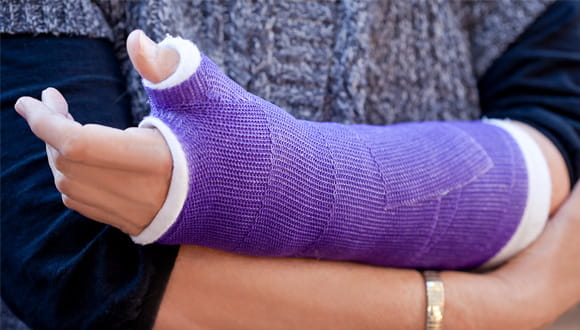The physical outcomes of a breaking a bone are fairly obvious. There's immediate pain and pain from the swelling. There's soreness from having to rely on muscles that are having to work overtime. If you try to do too much too soon, there's more swelling and more pain.
More frustrating than the pain, though, is probably the mental battle.
A broken bone often means losing your mobility and/or ability to perform basic tasks. And sure, sitting on the couch while your spouse cooks, cleans — does everything, really — every single night is nice, but it only takes a few days to reach a different sort of breaking point.
Between feeling guilty and/or bored, as well as pining over your lost independence, you ask the question that everyone with a broken bone hopes has a simple answer: What can I do to make this bone heal faster?
"When dealing with the inconvenience of a broken bone, this is an understandable question with a potentially unsatisfying answer. The reality is that the fastest way to heal a broken bone is to closely follow the instructions your doctor gives you," says Dr. Ashvin Dewan, orthopedic surgeon at Houston Methodist. "Rather than searching for ways to heal even faster, I recommend understanding how bones heal and knowing which behaviors help speed the healing process along so that you don't inadvertently slow it down instead."
How do bones heal?
"After breaking a bone, your body isolates the fracture site so that it's protected, and floods the area with the nutrients that promote healing," explains Dr. Dewan. "As healing progresses, your body begins to lay down new bone at the fracture site. This new bone hardens over the next several weeks. Once hardened and healed, the bone is then remodeled, reshaped and cleaned up over the course of the next year."
On average, a broken bone can take anywhere from six to eight weeks to heal before it can be used again. For young children, the healing process may happen more quickly. For older adults or those who have an underlying health condition, such as diabetes, healing can take longer.
"Healing a broken bone takes time, but, in terms of how to heal bones faster, three major themes of bone healing apply," says Dr. Dewan.
The three key steps to faster bone healing are:
- Alignment of the broken bone fragments
- Stability and support at the fracture site through immobilization
- Healthy lifestyle choices that promote healing
3 ways to heal bones faster
It's much easier for a bone to heal if the two fragments are aligned with one another. In some cases, the bone breaks and the fragments stay in line. In other cases, the bone fragments displace during the break, becoming unaligned, and your doctor has to manually reset them.
"Ensuring proper alignment of the bone fragments is an important first step. And while proper alignment must be maintained throughout the course of healing, it's the next two steps that become your main focus for the coming weeks. Unfortunately, these are the ones that can be hard to stay disciplined about," explains Dr. Dewan.
After breaking a bone, you leave the clinic with some gear and plenty of instructions. Your best bet for how to heal faster? Use the gear, follow the instructions — no exceptions.
1. Take your immobilization orders seriously
Understandably, one of the biggest challenges while recovering from a broken bone is remaining immobilized for an extended period of time. But it's also one of the most important things you can do to promote bone healing.
"Improperly immobilizing a broken bone can absolutely slow bone healing. If your doctor's orders were no weight bearing for two weeks, stay off the bone completely. Even if lightly bearing weight doesn't cause pain, it can place unnecessary stress on the fragile, healing fracture site," warns Dr. Dewan.
Not only does immobilization provide the stability that helps protect the fracture site and keep the bone fragments properly aligned, but it also helps promote the healing process and reduce painful swelling.
2. Focus on your diet
While waiting for your bone to heal, there are things you can do to help make sure healing progresses along quickly and smoothly.
"So much of the bone healing process is dependent on the biology surrounding the fracture site. A lot goes into promoting healing and laying new bone, and eating a healthy diet ensures your body has the nutrients, vitamins and minerals needed to support the biology of bone healing," explains Dr. Dewan.
A healthy diet is one full of vegetables, fruits, lean protein and water. In particular, calcium, vitamin D and protein will be important during the bone healing process, so be sure you're focusing on food sources rich in these nutrients, including dark, leafy greens, broccoli, fish, meat, yogurt, nuts and seeds.
"If you're younger, you should get sufficient amounts of these important nutrients by eating a well-balanced diet, and taking extra vitamin D or calcium won't necessarily accelerate your healing," says Dr. Dewan. "However, older individuals, as well as those who have vitamin deficiencies, may benefit from taking a vitamin D with calcium supplement."
3. If you smoke, stop
Lastly, there's one thing in particular Dr. Dewan warns can slow your healing down altogether: smoking.
"We know that smoking has a major impact on bone biology by negatively affecting the function of cells that create and lay new bone," explains Dr. Dewan. "Smoking is always unhealthy, but, while nursing a broken bone, it becomes an added detriment to your health."








